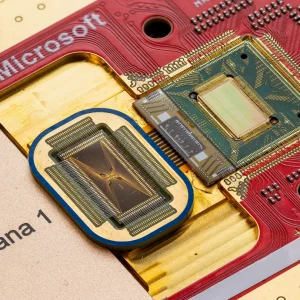
October was a big month for quantum technology in the British Isles. Barely three days in, the first quantum communications link was tested between the UK and Ireland. By using a fibre optic cable named “Rockabill” (not to be confused with the volcanic outcrop and all-round fishing dispute magnet Rockall), scientists were able to transmit packets of light across the Irish Sea without the customary degradation in the signal that companies are used to when transmitting information over that medium.

The team achieved this by harnessing certain peculiarities in quantum mechanics and using highly sensitive detecting instruments at either end of the connection. The research team in charge of the project hoped that their findings would help eradicate the tyranny of distance over the quality of mass communications. “This is a truly exciting step forward in realising the full potential of quantum communications and for the future of securing private data in an environment that is shaping the so-called ‘quantum internet’” explained University of York research lead Professor Marco Lucamarini.
Quantum leaps and AI institutes
A little-known cloud platform also had some quantum networking news. On October 17, AWS announced that it had, in collaboration with researchers from Harvard University, created its own novel packaging method for optical fibres that also tackled the problem of data degradation at great distances. The Amazon cloud platform’s solution involved placing the tapered end of an optical fibre in physical contact with the tapered end of an optical device, allowing light conveying the message to pass through the interface. By applying forces between the tapered ends, the researchers were able to inure the entire contraption against interference or shaking from outside sources – useful if you’d want to bury the repeater next to a road intersection, or a trampoline park.
As AWS tinkered with the power of light, so did the UK government with the discourse surrounding AI safety. On October 26, Prime Minister Rishi Sunak announced the establishment of the world’s first AI safety institute, intended to conduct risk assessments for new AI models. The new institute, he argued, would “carefully evaluate and test new types of AI so we can understand what new models are capable of,” since “right now, the only people testing the safety of AI are the very organisations developing it.”
The findings of the institute would, Sunak insisted, be shared with the world. That internationalist worldview also appeared to extend to telecommunications – to a certain degree, at least. Earlier in October, the UK joined the Global Coalition for Telecommunications, a new forum designed to “enhance the resilience of communication networks” and enhanced exchanges between member states about telecoms-related research and development.
Not everyone was included in this new club, however. As it turned out, Germany, France and South Korea were excluded from the Global Coalition, a move that one analyst connected to each country’s regulatory attitude toward Huawei. The Chinese telecoms provider had long been accused by UK and US intelligence services of exposing Western telecommunications networks to possible espionage by Beijing, an accusation that Huawei has repeatedly denied. Many nations, including the UK, had responded to these allegations by excluding Huawei from their networks and ripping out the firm’s equipment, but according to Disruptive Analysis’ Dean Bubley, Germany and France were being punished by the Global Coalition for their more “softly-softly” approach to the problem.
More from October 2023:
- Snap may have failed to identify and assess risks of My AI chatbot, ICO warns
- OpenAI plans major overhaul of developer offering
- Ofcom and CMA target AWS and Azure with UK cloud market antitrust probe






